Wilhelm Johannes Salewski
Wilhelm Johannes Salewski
September 20,1889, Chemnitz – 1.2.1950, Unterlengenhardt
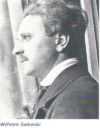 Four days after his ordination on September 16, 1922, and still during the founding events in Dornach, Wilhelm Salewski reached the age of thirty-three. He thus belonged to the middle-aged founders between the few older ones and the many very young ones. His birthday on September 20 fell on the ninth anniversary of the laying of the foundation stone for the first Goetheanum building.
Four days after his ordination on September 16, 1922, and still during the founding events in Dornach, Wilhelm Salewski reached the age of thirty-three. He thus belonged to the middle-aged founders between the few older ones and the many very young ones. His birthday on September 20 fell on the ninth anniversary of the laying of the foundation stone for the first Goetheanum building.
Wilhelm Salewski was born in Chemnitz in 1889, the first of twelve children – five brothers and six sisters. His father came from a Pomeranian family of farmers and millers and was working in the dairy business at the time of his first son’s birth. Five years later, the family moved to the Vistula lowlands. On various farms in Rospitz and Sedlinen, in the vicinity of the town of Marienwerder, his father tried to earn the bare necessities for the growing family.
The children grew up in this agricultural area. They had to help with all the work. Self-cut willow wood from the banks of the Liebe River and their own peat were the heating material for the harsh winters. The walk to school took an hour. Assaults by the village youth had to be endured.
Wilhelm Salewski was at the top of his class throughout his school years. He passed the Abitur at the grammar school in Marienwerder in 1908. His parents, therefore, wanted him to study despite the lack of money. He was to become a pastor. His father was a strict pietist in the “Community Movement” within the national church. Young Wilhelm became familiar with and enthusiastic about the great epoch of German idealism while still at grammar school. He used the Fichte saying, “To have character – is to be German” as a motto in his graduation speech after leaving school.
Instead of theology, however, Wilhelm Salewski studied philosophy and philology in Greifswald, Marburg, Tübingen, and Berlin. From 1910 onward, the family lived In Dresden, where the father now ran a dairy wholesale business. There, the younger sisters and brothers experienced their big brother playing the piano for them, singing to the lute on hikes in the Ore Mountains, or opening up the world of paintings to them in the Gemäldegalerie [Old Masters’ Gallery] with Raphael’s Sistine Madonna and taking them to the opera.
With the outbreak of the First World War, he volunteered. He went with the ‘Grimma Hussars’ to the battles in Flanders. Later he fought in a machine-gun troop in Hungary, where he was also wounded. At the end of the war, we find him as a lieutenant in the military hospital in Leipzig. His brother Paul was killed in action in 1917.
Unfortunately, it is no longer possible to determine when Wilhelm Salewski became acquainted with anthroposophy, only that it happened through his encounter with the theatre troupe around Gottfried Haaß-Berkow. In any case, the doctoral thesis he submitted in Leipzig in 1919 was not accepted because it contained anthroposophical ideas.
Siblings still remember this time: how they heard their elder brother enthusiastically talking about Rudolf Steiner and anthroposophy. Some sisters later found their way to The Christian Community, and his younger brother Hugo also became one of their priests in 1927. The most profound experience in Wilhelm Salewski’s biography was his participation in the opening weeks of the first Goetheanum building in Dornach, which Rudolf Steiner introduced with the motif in his address that in the future, science, religion, and art must be renewed from the spirit so that they can work together in a renewed way for a future culture. This is what the Goetheanum wants to serve.
The Anthroposophical Society engaged the “Thuringian philosopher” from Leipzig, who was involved there as a speaker in the threefold social order initiative in Elise Wolfram’s branch. Especially in the Ruhr area, he gave lectures to entrepreneurs and proletarians and had conversations with them. When the initiative soon had to be abandoned, Wilhelm Salewski worked as a home teacher in Bremen and also at a rural educational home. But he continued to be active in the anthroposophical movement, especially as a speaker on Goethe. In 1921, an essay by him appeared in the journal Die Tat, which Rudolf Steiner mentioned with praise in one of his lectures (on February 8, 1921, in GA 203, 1978, p. 213). Thus we see him already tried and tested in spiritual work when he came across the circle of founders of The Christian Community and immediately recognized the liturgical work he wanted to take on as the most important means in the struggle to overcome materialism and intellectualism.
From the autumn course in 1921 onwards, he was involved in every step of the founding of The Christian Community. He prepared the founding of the congregation in Düsseldorf but was then active in Karlsruhe for years until he moved to Stettin, where he remained until the Second World War. At a meeting of The Christian Community in Mannheim (October 1927), which Wilhelm Salewski had helped to prepare, he invited Marie Steiner and her Dornach speech choir to participate. These choral performances were the first outside Dornach and marked the beginning of a rich touring activity through many European countries.
He spent the first days of the prohibition period in 1941 in prison. After the Second World War, he worked as a priest in Bayreuth. For many months in 1949, he suffered from a serious illness which brought him to Unterlengenhardt (in the Black Forest) to the Burghalde clinic, where he died on February 1, 1950.
Not particularly tall, he was nevertheless a striking figure, stern-looking, with an eagle’s nose and a slightly melancholy expression around his mouth. His strong soul often seemed inhibited. His unhappy marriage remained without children. Those around him experienced him as somewhat reserved, almost withdrawn, and sometimes even brusque. He pondered a lot about the problem of evil.
Through countless lectures, he had worked for the first foundation of The Christian Community. There is hardly an issue of The Christian Community magazine in which he did not publish an essay, a story, a poem, or a book review. In 1931, Wilhelm Salewski’s only book publication appeared: Die Psychoanalyse Sigmund Freuds, Grundfragen und Konsequenzen – Als Protest gegen den Verleihung des Goethepreises an Sigmund Freud [The Psychoanalysis of Sigmund Freud, Basic Questions and Consequences – As a Protest against the Awarding of the Goethe Prize to Sigmund Freud]. He self-published “Briefe” (essays) with the overall title Goethes Wesen und Werk [Goethe’s Essence and Work].
Throughout his life, he had felt the mandate to continue to stand up for anthroposophy. In 1948 he wrote to the aged Marie Steiner, whose reply on the relationship between anthroposophy and The Christian Community is an important document: “… That is why your letter touched me. I cannot think that it is still a question of which of our movements will triumph over the other and how we should delimit our fields of work from each other. I think we must seek ways of fusion …. With best regards Marie Steiner. “ [Cf. the book: Marie Steiner und die Christengemeinschaft [Marie Steiner and The Christian Community] by Wolfgang Gädeke (Stuttgart).]
On the painting by Rembrandt
“Christ and the Disciples in Emmaus”
How familiar Emmaus is to me. –
I have to paint it again and again.
I saw Him walking with His own
through the evening field and hear His words:
… “suffering in Jerusalem … ”
… “enter into His glory … ”
and my heart burns within me.
You earth, shining with dew
golden grain, you silent animals,
how you are one in His peace.
You poor hut, more gloriously adorned
than Solomon’s consecrated temple.
I enter with Him, –
He breaks the bread, –
and flaming, glowing I saw in the hut a sun….
–Wilhelm Salewski
MEMORANDUM
The Dornach theological course gave me the opportunity to recognize the essence of a contemporary liturgy and its absolute necessity for our present. Since the day I understood that intellectualism and materialism could be overcome through a liturgy, I have remained unwavering in my determination to work on the religious renewal of our people in the way that has been shown to us. The deepest essence of all that has been given to us by Dr. Steiner proves itself to me through the daily effect of strength that emanates from it. I hope and long that we will soon have the opportunity to work outwards.
Charlottenburg, March 4, 1922
- Salewski

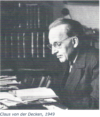 The midwife had to navigate the flooded Elbe meadows to get to Claus von der Decken’s birth on October 5, 1888, at Preeten Castle near Neuhaus. Claus was the second of four children who were joined by a foster sister. His father, Ernst, from the old Hanoverian landed gentry, was the administrator of various estates. His mother, Anna, was born von Arnswald, whose three sisters were abbesses of the noble convents of Bassum, Medingen, and Ebstorf. Anyone who was brought into a noble convent had to have sixteen full noble great-great-grandparents.
The midwife had to navigate the flooded Elbe meadows to get to Claus von der Decken’s birth on October 5, 1888, at Preeten Castle near Neuhaus. Claus was the second of four children who were joined by a foster sister. His father, Ernst, from the old Hanoverian landed gentry, was the administrator of various estates. His mother, Anna, was born von Arnswald, whose three sisters were abbesses of the noble convents of Bassum, Medingen, and Ebstorf. Anyone who was brought into a noble convent had to have sixteen full noble great-great-grandparents. On the Eschenhof, the family had to endure difficult destinies, both humanly and in terms of health. Cécile von der Decken died in 1928, two years after the birth of her seventh child. Four years of family separation followed. The three older children moved with the Schmidt family to Kassel-Wilhelmshöhe to attend the Waldorf School. The three younger children stayed in Lübeck with their father and were looked after by his mother and sister.
On the Eschenhof, the family had to endure difficult destinies, both humanly and in terms of health. Cécile von der Decken died in 1928, two years after the birth of her seventh child. Four years of family separation followed. The three older children moved with the Schmidt family to Kassel-Wilhelmshöhe to attend the Waldorf School. The three younger children stayed in Lübeck with their father and were looked after by his mother and sister.

 In addition to his work as a classroom teacher, he was soon appointed as a teacher of independent Christian religious education with the task of holding Sunday services as well. His religious groups had over sixty children! During the same period, people repeatedly turned to him – or were sent to him by Rudolf Steiner –requesting baptisms or marriages.
In addition to his work as a classroom teacher, he was soon appointed as a teacher of independent Christian religious education with the task of holding Sunday services as well. His religious groups had over sixty children! During the same period, people repeatedly turned to him – or were sent to him by Rudolf Steiner –requesting baptisms or marriages.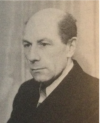 Hermann Fackler, too, was already a long-serving pastor when The Christian Community was founded. At thirty-six, he belonged to the group of the older ones at that time. Nevertheless, he was still able to serve the movement for over fifty years.
Hermann Fackler, too, was already a long-serving pastor when The Christian Community was founded. At thirty-six, he belonged to the group of the older ones at that time. Nevertheless, he was still able to serve the movement for over fifty years.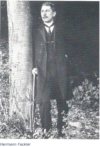 In the autumn of the following year (1921), he took a short holiday with his wife in nearby Waldshut that was broken off after a week due to inner turmoil. At home, a single letter was found that had not been forwarded. It was an invitation from a completely unknown Rudolf Meyer from Stuttgart to come to Dornach for the theology course which was about to begin.
In the autumn of the following year (1921), he took a short holiday with his wife in nearby Waldshut that was broken off after a week due to inner turmoil. At home, a single letter was found that had not been forwarded. It was an invitation from a completely unknown Rudolf Meyer from Stuttgart to come to Dornach for the theology course which was about to begin. In the fifties, it was possible to buy a house and build a community room in Goethean style, which still serves the community today. Beginning with the first volume of The Christian Community magazine, a wealth of essays by Hermann Fackler has appeared, reflecting the breadth of his education and interests. He also published articles in other journals and newspapers, such as Die Kommenden, Blätter für Anthroposophie, Entscheidung, Die Drei, Die Tat, and others. He also wrote poetry and painted. As a lecturer, however, he was less prominent. He worked in silence through many visits and conversations and appeared outwardly closed.
In the fifties, it was possible to buy a house and build a community room in Goethean style, which still serves the community today. Beginning with the first volume of The Christian Community magazine, a wealth of essays by Hermann Fackler has appeared, reflecting the breadth of his education and interests. He also published articles in other journals and newspapers, such as Die Kommenden, Blätter für Anthroposophie, Entscheidung, Die Drei, Die Tat, and others. He also wrote poetry and painted. As a lecturer, however, he was less prominent. He worked in silence through many visits and conversations and appeared outwardly closed.
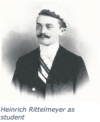 But the confirmand already got into difficulties because he had to profess a faith that would bind him for life. When, in the same year, his brother Friedrich, who was seven years older, traveled home from his intermediate semesters in Berlin and had conversations with the confirmand, further uncertainties arose; years of doubt followed. Yes, Heinrich Rittelmeyer felt himself to be a ‘heretic.’ But he was quite sure: “God is a reality, and the divinity of Christ is a reality because they had brought about the change in my temperament.”
But the confirmand already got into difficulties because he had to profess a faith that would bind him for life. When, in the same year, his brother Friedrich, who was seven years older, traveled home from his intermediate semesters in Berlin and had conversations with the confirmand, further uncertainties arose; years of doubt followed. Yes, Heinrich Rittelmeyer felt himself to be a ‘heretic.’ But he was quite sure: “God is a reality, and the divinity of Christ is a reality because they had brought about the change in my temperament.” mythology, he applied to the Westphalian Minister of Culture to go to the area where the memory of Germanic history was alive. His professional responsibilities in Herford became even greater.
mythology, he applied to the Westphalian Minister of Culture to go to the area where the memory of Germanic history was alive. His professional responsibilities in Herford became even greater.